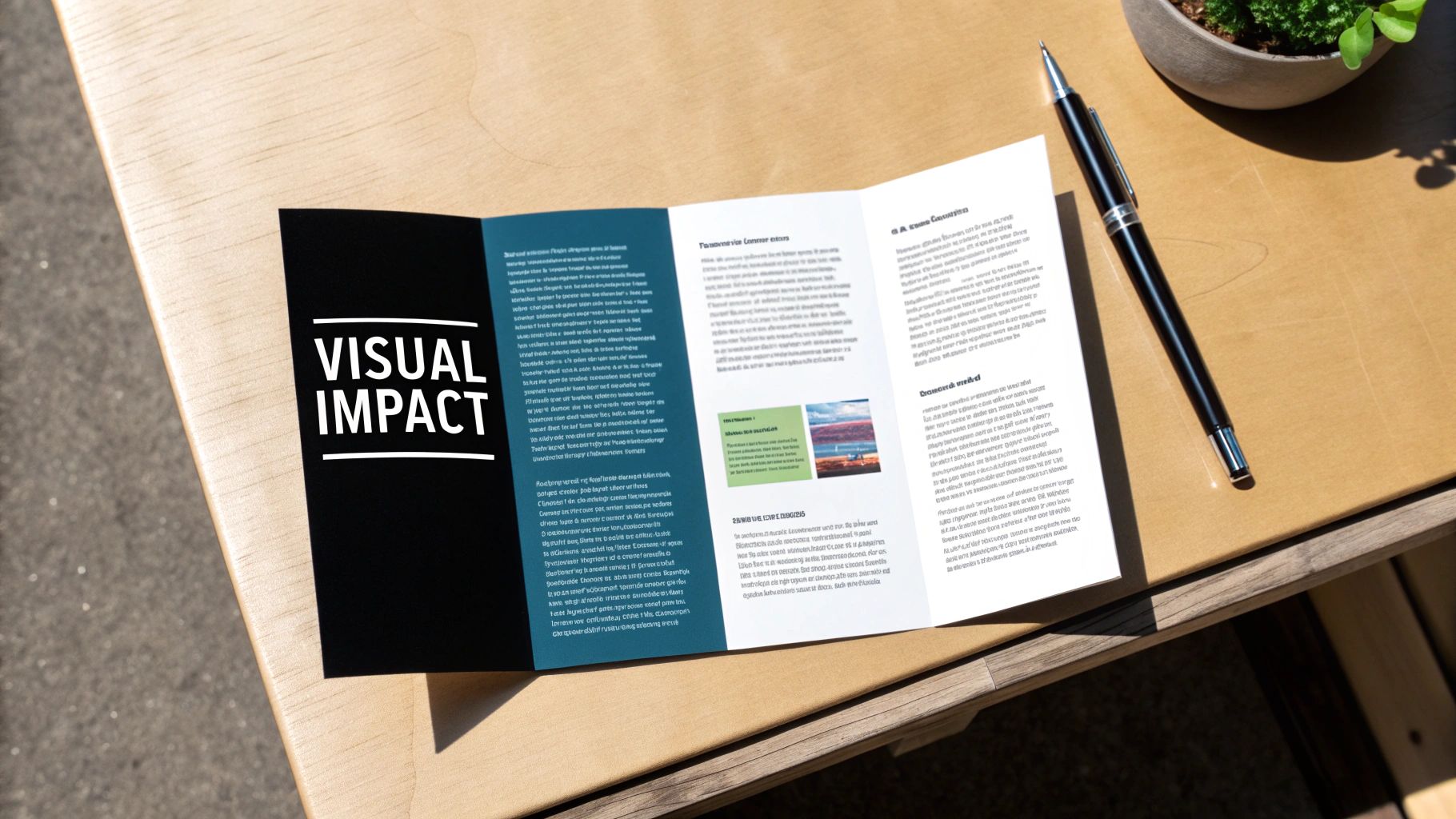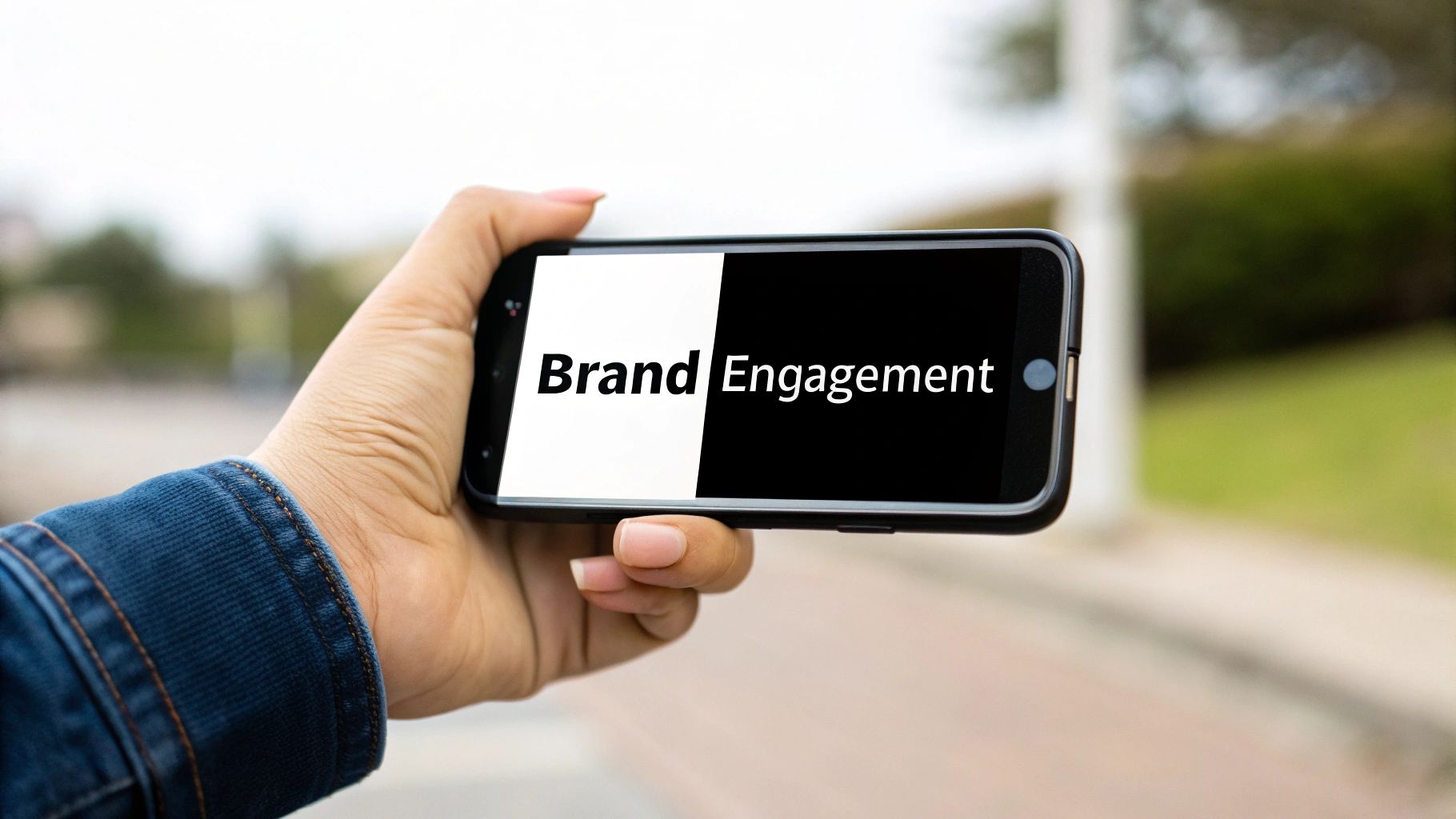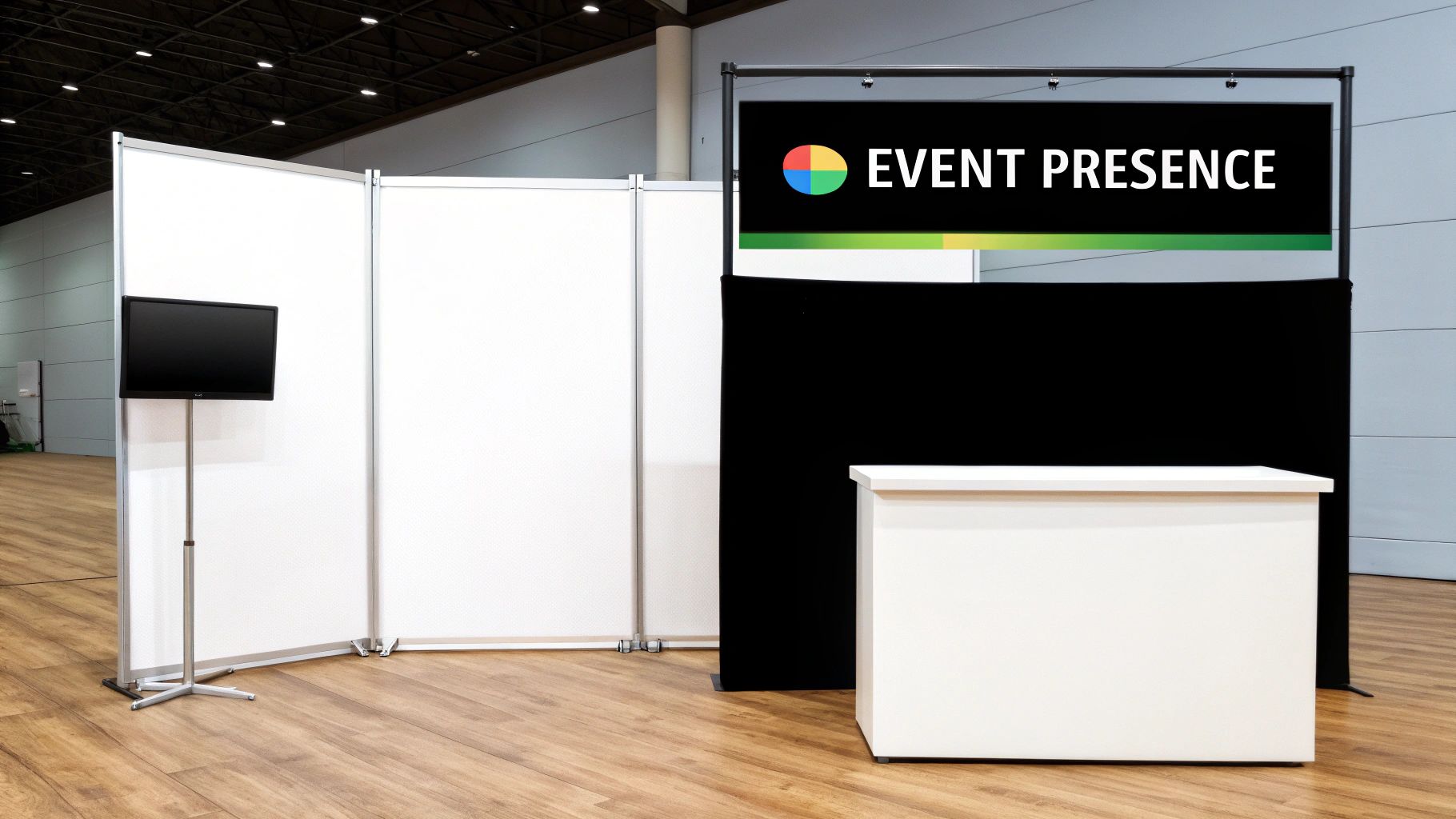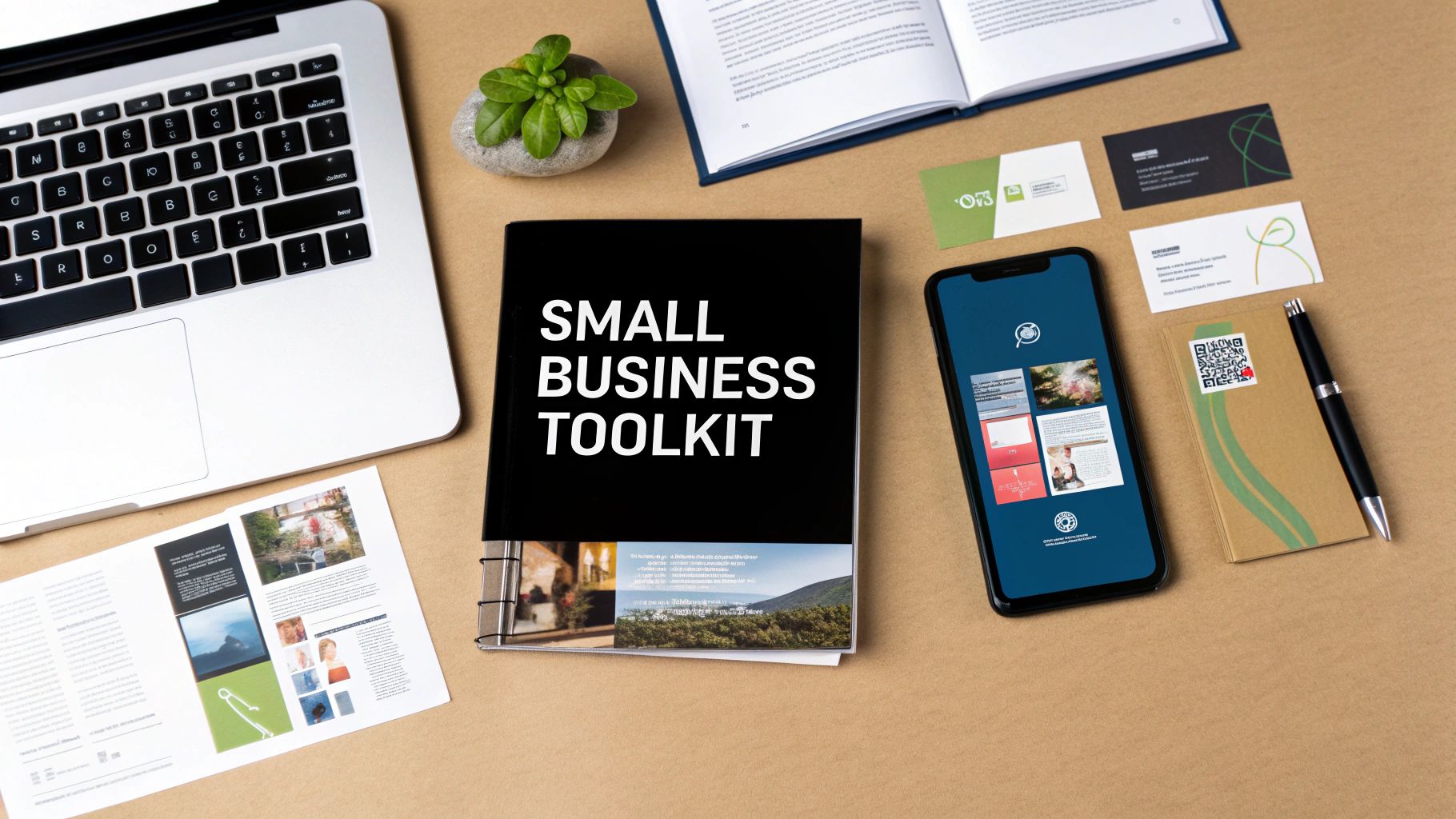In today's competitive market, building a memorable brand requires more than just a great product or service. You need a strategic collection of tools that work together to attract, engage, and convert your ideal customers. But where do you start? The world of small business marketing materials can feel overwhelming, spanning everything from the classic business card to sophisticated digital campaigns. For those looking to build a robust digital toolbox, exploring effective SEO services for small businesses is often a crucial step towards online success, complementing the tangible assets we'll discuss.
This guide cuts through the noise. We will explore nine essential types of marketing materials, both print and digital, that provide the foundation for sustainable growth. We’ll move beyond generic advice to give you actionable insights, practical implementation tips, and real-world examples to help you select, design, and deploy each asset effectively. Whether you're a new startup creating your first promotional items or an established business looking to refresh your strategy, this roundup will equip you with the knowledge to build a powerful and cohesive marketing arsenal. Let's dive into the core components that will help your brand stand out.
1. Business Cards
In our digital-first world, the humble business card remains one of the most effective and personal small business marketing materials. More than just a slip of paper with your contact details, a well-designed business card is a physical extension of your brand identity. It provides a tangible, memorable token that keeps you top-of-mind long after a conversation ends.

This simple tool facilitates powerful, face-to-face networking. Exchanging cards creates a moment of connection that an email or LinkedIn request can't replicate. It signals professionalism and preparedness, showing potential clients and partners that you are serious about your business.
Why Business Cards Still Matter
A business card is your opportunity to make a lasting first impression. A premium card can convey quality and attention to detail before a client even visits your website. It’s a low-cost, high-impact tool that should be in every business owner's toolkit, perfect for industry events, client meetings, or even chance encounters.
Actionable Tips for Effective Business Cards
- Invest in Quality: Use high-quality, thick card stock (at least 16pt or 350gsm). The tactile feel communicates a premium brand image. Consider unique finishes like spot UV or embossing for key elements like your logo.
- Embrace Modern Tech: Add a QR code that links directly to your portfolio, a special landing page, or your LinkedIn profile. This bridges the gap between your physical and digital presence.
- Keep It Clean: Don’t overcrowd the design. Stick to essential information: your name, title, company name, phone number, email, and website. Ensure the font is clean and legible.
- Follow Up Promptly: When you receive a card, make a note on the back about your conversation. Follow up with a personalized email within 48 hours to solidify the connection.
2. Brochures and Flyers
Brochures and flyers are versatile and tangible small business marketing materials that allow you to tell a more detailed story than a business card can. A well-crafted brochure acts as a portable salesperson, providing in-depth information about your services, products, or company history. Flyers, on the other hand, are perfect for announcing specific events, sales, or grand openings with immediate visual impact.

These printed pieces can be left at reception desks, included in sales packets, or distributed at trade shows. They give potential customers something concrete to review at their leisure, reinforcing your message and brand identity. From a local fitness center promoting new classes to a real estate agent showcasing a property, these materials are designed to inform and persuade.
Why Brochures and Flyers Are Effective
In an age of digital noise, a high-quality brochure offers a focused, distraction-free reading experience. It establishes credibility and demonstrates a level of investment in your business. They are ideal for situations where you need to communicate more complex information, such as a medical practice detailing a procedure or a tour company outlining a destination package.
Actionable Tips for Effective Brochures and Flyers
- Focus on a Strong Headline: Grab attention immediately with a headline that speaks to a customer's need or offers a clear benefit. Your value proposition should be impossible to miss.
- Use High-Quality Imagery: Invest in professional photography or high-resolution stock images that align with your brand. Visuals should tell a story and support the text.
- Guide the Reader: Use clear headings, bullet points, and a logical flow to make the information easy to digest. A tri-fold brochure, for example, should guide the reader from one panel to the next.
- Include a Clear Call-to-Action (CTA): Tell your audience exactly what to do next. Whether it's "Call Today for a Free Consultation," "Visit Our Website to See More," or "Scan to Book Now," your CTA should be prominent and compelling.
3. Social Media Graphics
In today's highly visual digital landscape, custom-designed social media graphics are essential small business marketing materials. These visuals are more than just pretty pictures; they are strategic tools for communication, designed to stop the scroll, capture attention, and convey your brand’s message instantly. High-quality, on-brand graphics are crucial for building a professional and cohesive online presence that resonates with your target audience.

From Instagram stories showcasing a daily special to Facebook posts announcing a new service, tailored graphics make your content more engaging and shareable. They transform abstract data, testimonials, and promotions into easily digestible visual formats, significantly boosting your ability to connect with followers and drive meaningful action.
Why Social Media Graphics Are Crucial
A strong visual strategy directly impacts how your brand is perceived online. Consistent and professionally designed graphics build brand recognition and trust, making your business memorable in a crowded feed. This approach allows you to effectively communicate your value proposition and improve brand awareness across platforms, turning passive scrollers into active followers and customers.
Actionable Tips for Effective Social Media Graphics
- Create Brand Templates: Use tools like Canva or Figma to create a library of reusable templates. This ensures brand consistency across all posts and dramatically speeds up your content creation process.
- Optimize for Each Platform: Tailor your graphic dimensions for each social network (e.g., square for Instagram feeds, vertical for Stories). This ensures your visuals look professional and are not awkwardly cropped.
- Prioritize Readability: Use high-contrast colors and clear, bold fonts for any text overlays. Your message should be easy to read in a matter of seconds, even on a small mobile screen.
- Include a Clear Call-to-Action (CTA): Tell your audience what you want them to do next. Use action-oriented text like "Shop Now," "Learn More," or "Book Your Spot" directly on the graphic to guide users.
4. Website Landing Pages
Unlike a general website homepage, a landing page is a specialized, standalone web page designed with a single, focused objective. As one of the most powerful digital small business marketing materials, its purpose is to convert visitors from a specific campaign into leads or customers by eliminating distractions like navigation menus and multiple calls-to-action.
This razor-sharp focus is what makes landing pages so effective. Whether you're running a paid ad, promoting a webinar, or launching a new product, sending traffic to a dedicated landing page dramatically increases the likelihood of a visitor taking the desired action, such as signing up for a free trial or downloading an e-book.
Why Landing Pages Are Essential
A landing page acts as the digital destination for your marketing campaigns, ensuring your message and offer are perfectly aligned. By tailoring the content to a specific audience and goal, you create a seamless user journey that guides visitors directly toward conversion. They are crucial for measuring campaign ROI and optimizing your marketing spend.
Actionable Tips for Effective Landing Pages
- Use a Compelling Headline: Your headline must immediately grab attention and communicate the value of your offer. Address a specific pain point or a clear benefit to make visitors want to learn more.
- Keep Forms Simple: Only ask for the information you absolutely need. A long, complicated form is a major cause of abandonment. For an initial lead, a name and email address are often enough.
- Include Trust Signals: Add testimonials, client logos, case studies, or security badges to build credibility and reduce friction. Social proof shows potential customers that others have trusted you and had a positive experience.
- Optimize for Speed and Mobile: Ensure your page loads in under three seconds and is fully responsive on all devices. A slow or poorly formatted page on mobile will send your conversion rates plummeting.
5. Email Marketing Campaigns
Email marketing is one of the most powerful and direct small business marketing materials, allowing you to build and nurture relationships directly in your customers' inboxes. Unlike social media, you own your email list, giving you a direct line of communication that isn't dependent on algorithms. It’s a versatile tool for promoting products, sharing news, and guiding customers through their journey.
This digital medium excels at personalization. You can send targeted messages based on past purchases, browsing behavior, or expressed interests, making each communication feel relevant and valuable. From automated welcome sequences to promotional newsletters, email campaigns keep your brand top-of-mind and drive repeat business.
Why Email Marketing Campaigns Are Essential
Email marketing consistently delivers one of the highest returns on investment (ROI) of any marketing channel. It's a cost-effective way to engage a captive audience that has already opted in to hear from you. For nurturing leads, recovering abandoned carts, or launching new services, email provides a measurable and scalable solution for driving conversions and fostering loyalty.
Actionable Tips for Effective Email Marketing Campaigns
- Segment Your List: Don't send the same email to everyone. Group your subscribers based on their behavior, demographics, or purchase history to send highly relevant content that resonates.
- Craft Compelling Subject Lines: Your subject line is your first impression. Keep it short, intriguing, and honest to boost open rates. Use personalization, like the recipient's name, to grab attention.
- Include a Clear Call-to-Action (CTA): Every email should have a purpose. Use a prominent button or link that tells subscribers exactly what to do next, whether it’s "Shop Now," "Read More," or "Book a Consultation."
- Optimize for Mobile: Most emails are now opened on mobile devices. Ensure your design is responsive, with large fonts, single-column layouts, and easily tappable buttons for a seamless user experience.
6. Direct Mail Postcards
In an era dominated by overflowing inboxes, direct mail postcards offer a powerful, tangible way to cut through the digital clutter. These physical cards, sent directly to a targeted audience, provide a unique touchpoint that lands right in a potential customer's hands. A well-designed postcard can grab attention instantly, making it one of the most effective small business marketing materials for local outreach.
This classic marketing tool allows for precise targeting, from specific neighborhoods to demographic segments. For businesses like restaurants announcing a grand opening or real estate agents showcasing recent sales, postcards create immediate local awareness and drive foot traffic in a way that digital ads sometimes can't.
Why Direct Mail Postcards Work
A postcard’s value lies in its directness and simplicity. There’s no envelope to open, so your message is seen instantly. This immediate exposure, combined with a compelling offer, makes it a high-impact, low-barrier marketing tactic perfect for generating leads, announcing sales, or re-engaging past customers.
Actionable Tips for Effective Direct Mail Postcards
- Design for Impact: Use a bold, eye-catching headline and vibrant imagery. Your design needs to capture attention in the split second it takes to walk from the mailbox to the recycling bin.
- Create a Compelling Offer: Include a strong call to action (CTA) tied to an irresistible offer, like a "new patient special" for a dental office or a "15% off your first service" for a landscaper.
- Keep It Simple and Scannable: The message should be concise and easy to understand at a glance. Use bullet points and short sentences to highlight key benefits and details.
- Target Precisely and Track Results: Use services like USPS Every Door Direct Mail (EDDM) to target specific postal routes. Include a unique coupon code, QR code, or landing page URL to track the campaign’s ROI effectively.
7. Trade Show Displays
For businesses aiming to make a significant impact at conferences, expos, and industry events, professional trade show displays are indispensable. These displays are more than just backdrops; they are carefully engineered environments designed to attract foot traffic, communicate your brand story, and facilitate meaningful conversations. They transform a standard booth space into an immersive brand experience.

A well-executed display serves as a powerful magnet, drawing potential customers in from crowded event floors. It acts as the physical centerpiece of your event marketing strategy, creating a dedicated space for demonstrations, networking, and lead generation. For B2B companies, especially in tech and manufacturing, this is a prime opportunity to showcase products and expertise directly to a highly targeted audience.
Why Invest in Professional Displays
A professional trade show display instantly communicates credibility and seriousness. It shows you have invested in your presence and value the opportunity to connect with attendees. In a sea of competitors, a visually striking and well-organized booth can be the deciding factor that makes a prospect stop and engage with your team instead of walking by.
Actionable Tips for Effective Trade Show Displays
- Design for Visibility: Use large, bold graphics and a clear, concise headline that can be read from a distance. Your core value proposition should be obvious to someone scanning the aisle.
- Create an Engaging Experience: Incorporate interactive elements like a product demo station, a tablet for signing up, or a contest. Train your booth staff to be proactive, friendly, and knowledgeable.
- Systemize Lead Capture: Use a digital tool or a simple system to collect contact information efficiently. Qualify leads on the spot by asking targeted questions about their needs and purchase timeline.
- Measure Your ROI: Track the leads generated from the event and monitor their journey through your sales funnel. This data is crucial for evaluating the event's success and planning for future ones.
8. Promotional Products
Promotional products, or branded merchandise, are tangible items given to customers, prospects, and employees to boost brand visibility. These practical gifts serve as lasting advertisements, keeping your business in the user's daily life far longer than a digital ad. From a coffee shop's branded mug to a tech startup's custom USB drive, these items create positive, real-world connections.
Unlike other forms of marketing that can feel fleeting, a physical product has staying power. It transforms your brand from an abstract concept into a useful tool, fostering goodwill and repeated exposure every time the item is used. This makes them exceptional small business marketing materials for building long-term loyalty.
Why Promotional Products Work
A well-chosen promotional item integrates your brand into your audience's routine. It's a gesture that shows appreciation and delivers value beyond your core service, making recipients more likely to remember and recommend your business. For a detailed look at tangible items, consider exploring the latest trends and the Top Small Business Promotional Products for 2025.
Actionable Tips for Effective Promotional Products
- Prioritize Practicality: Choose items your target audience will actually use. A fitness center might offer branded water bottles, while a real estate agent could provide high-quality keychains.
- Focus on Quality: A cheap, flimsy product reflects poorly on your brand. Invest in durable, well-made items that communicate quality and create a positive association.
- Align with Brand Values: Ensure the product makes sense for your business. An eco-friendly company should opt for sustainable items like reusable tote bags or bamboo pens.
- Keep Branding Subtle but Clear: Your logo should be visible but not overwhelming. Include essential contact information, like your website, only if it fits naturally into the design without creating clutter.
9. Content Marketing Materials
Content marketing materials are educational, valuable assets designed to attract and engage a target audience rather than directly promoting your brand. By creating blog posts, guides, whitepapers, or case studies, you provide solutions to your audience's problems, positioning your business as a trusted industry expert and nurturing leads through the sales funnel.
This strategic approach, popularized by companies like HubSpot, focuses on drawing customers in with relevant and helpful information. For example, a software company might publish technical guides, while a healthcare provider could create patient education articles. This builds a relationship based on trust and value, making a sale the natural next step.
Why Content Marketing Materials Matter
These materials are foundational to modern digital marketing. They fuel your SEO efforts, provide shareable assets for social media, and give your sales team resources to educate prospects. By consistently publishing high-quality content, you build brand authority and create a library of assets that generate leads and traffic over the long term, making it one of the most sustainable small business marketing materials available.
Actionable Tips for Effective Content Marketing
- Solve, Don't Sell: Focus every piece of content on solving a specific problem or answering a question for your audience. Your expertise is the hook, not your product pitch.
- Establish Content Pillars: Identify 3-5 core topics your business wants to be known for. Build your content strategy around these pillars to create a cohesive and authoritative body of work.
- Optimize for Search: Research relevant keywords and incorporate them naturally into your content. Use clear headings, meta descriptions, and alt text to help search engines understand and rank your pages. For more ideas on how your content reinforces your identity, check out these branding tips for small businesses.
- Repurpose and Recycle: Turn a comprehensive blog post into a series of social media updates, a video script, or an infographic. This maximizes the value of your initial effort and reaches audiences on different platforms.
Small Business Marketing Materials Comparison
From Materials to Momentum: Activating Your Brand Strategy
We've explored a comprehensive arsenal of small business marketing materials, from the tangible impact of a well-designed business card to the digital reach of a targeted email campaign. Each item, whether it's a trade show display, a promotional product, or a compelling blog post, serves a distinct purpose. However, their true power isn't in isolation; it's in their ability to work together as a unified system.
The most critical takeaway is the principle of brand consistency. Your logo, color scheme, typography, and tone of voice are not just design elements. They are the threads that weave your entire brand story together, creating a seamless and memorable experience for your audience across every touchpoint. When a customer receives your brochure, sees your social media ad, and lands on your website, the visual and verbal identity should be instantly recognizable and reassuring. This cohesion is what builds trust and transforms casual interest into loyal advocacy.
Turning Knowledge into Action
Simply knowing what materials you need is only the first step. The real challenge, and the greatest opportunity, lies in strategic implementation. To move forward effectively, consider these actionable next steps:
- Conduct a Brand Audit: Gather all your existing marketing materials. Lay them out side-by-side and ask critical questions. Do they look and feel like they come from the same company? Is the messaging consistent? Identify any weak links or outdated assets that need to be refreshed or retired.
- Prioritize Based on Goals: You don't need to create everything at once. If your primary goal is generating leads at an upcoming conference, focus your resources on perfecting your business cards, brochures, and trade show display. If you're focused on online growth, prioritize your website, social media graphics, and content marketing.
- Create a Brand Style Guide: Formalize your brand identity by creating a simple style guide. This document should outline your official logo usage, color codes (HEX, CMYK), primary and secondary fonts, and key messaging points. It will serve as an essential reference for you, your team, and any future collaborators, ensuring consistency as you scale.
The Long-Term Value of a Cohesive Brand
Investing time and resources into creating a professional and unified set of small business marketing materials is not an expense; it's a direct investment in your company's future. It elevates your brand above the noise, communicates professionalism, and makes your marketing efforts more efficient and effective. As your business grows, your strategy will naturally evolve. Sometimes, this evolution may even call for a larger strategic shift. For inspiration on strategic brand evolution, explore these iconic rebranding efforts.
Ultimately, these materials are the vehicles that carry your brand's promise to your customers. By ensuring they are strategic, consistent, and high-quality, you build more than just a customer base; you build brand momentum that can propel your business toward sustained success.
Ready to build a powerful brand ecosystem that ties all your marketing materials together? Softriver specializes in delivering complete, professional branding packages, from logos and style guides to social media assets and more, with unmatched speed and quality. Get a cohesive brand identity that sets your business up for success.







